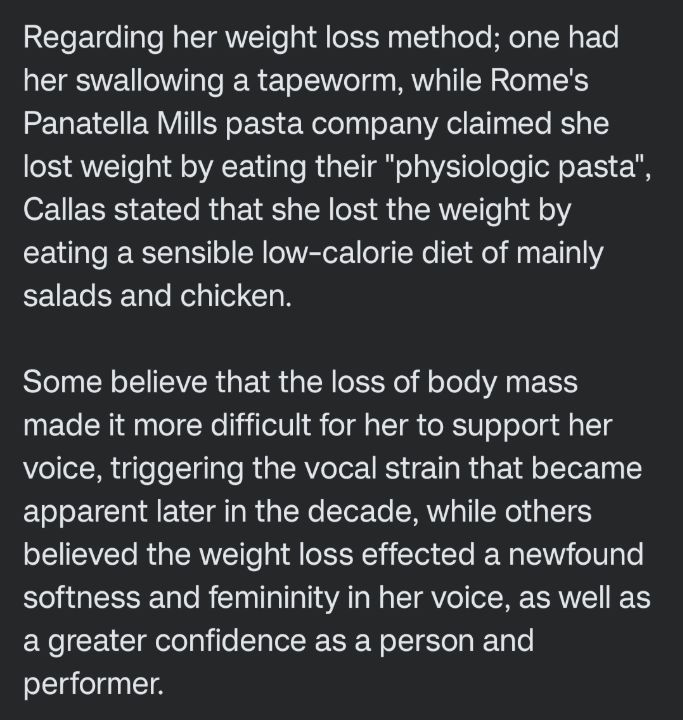Maria Callas’ life was as operatic offstage as it was onstage, and her dramatic weight loss is still one of the most talked-about—and tragic—parts of her story. Born in 1923, she shot to fame in the late 1940s, a time when opera singers were often admired for their big, commanding physiques, which matched the powerful voices their art demanded. When Callas had her big breakthrough in 1947, she weighed around 238 pounds. Back then, her look fit the traditional image of an opera singer, but for Callas, it was a huge source of insecurity. She was painfully self-conscious about her body and very aware of how harsh the public and media could be about her appearance.
Maria Callas Had an Insane Weight Loss Transformation—See Before and After Pictures Below!

Maria Callas’ dramatic weight loss really took off around 1953 when she was 30. Word is, she was partly pushed by outside pressures. Big names in the opera world, like director Luchino Visconti, reportedly labeled her “fat” and told her to slim down—Visconti even said he wouldn’t work with her unless she lost at least 66 pounds.
But it wasn’t just them. Callas had always admired Hollywood stars like Audrey Hepburn, with her slim, graceful look that set a new standard for beauty and elegance. Inspired (and maybe a bit obsessed) with this ideal, Callas went on an extreme diet that some called downright unhealthy, shedding an incredible 88 pounds in less than two years. By 1954, the once larger-than-life soprano was almost unrecognizable, transformed into a slender, elegant figure.

Nobody really knows how she lost all that weight, but the rumors fly—everything from tapeworms to extreme dieting. Most likely, Callas just ate way less, to the point where we’d probably call it disordered eating today. Pictures from back then show just how big the change was. Before, she had a full, strong, almost matronly look. Afterward, her face was sharp, her cheekbones hollow, and her figure completely transformed. The opera world was floored. Some people loved her “new look,” while others worried she’d lost some of the physical presence that made opera so powerful.

Maria Callas’ dramatic weight loss had a major impact on both her career and her personal life. People have debated for years whether her sudden transformation played a role in her vocal decline. Her voice, once unmatched in richness, agility, and power, started to show signs of wear in the mid-1950s. Even Callas noticed the change—some performances were brilliant, but others were shaky, with her struggling to hit and hold high notes.
Experts think the weight loss may have weakened her diaphragm and core muscles, which are key for the powerful, controlled singing bel canto demands. Others believe it might have worsened a health issue she later found out she had—dermatomyositis, a rare inflammatory disease that affects muscles and can strain the voice.
Losing weight took a serious emotional toll on her. Sure, Callas finally got the waif-like figure she’d always admired, but it only made her insecurities worse. She’d spent so much of her life feeling like she wasn’t enough, and her new look didn’t exactly boost her confidence. Callas became super sensitive to criticism, especially from people who claimed her voice had declined because she was chasing beauty. For someone whose whole identity revolved around her voice, the idea of losing it—whether it was true or not—was absolutely crushing.

Her weight loss also kicked off a pretty chaotic time in her life. In the years that followed, Maria Callas got caught up in a stormy relationship with Greek shipping tycoon Aristotle Onassis. His arrival in her life was a mix of thrilling and toxic—he introduced her to a world of excess, including prescription drugs like pentobarbital and methaqualone. Over time, she leaned more and more on these substances, maybe as a way to deal with the constant pressure of her career and her declining health.
By the 1960s, Maria Callas’ voice was struggling even more, and the public scrutiny only grew. Her last operatic performance, Tosca at London’s Covent Garden in 1965, was like the curtain closing on her singing career. She was just 41.
In her later years, Maria Callas faced a lot of challenges, including health issues and loneliness. In the 1970s, she was diagnosed with dermatomyositis, a condition that causes chronic muscle inflammation and likely played a role in her vocal struggles. The treatments, which included corticosteroids and immunosuppressants, took a heavy toll on her body. Living alone in her Paris apartment, Callas passed away from a heart attack on September 16, 1977, at just 53 years old. While the official cause was heart failure, many believe that emotional trauma, addiction, and the effects of her illnesses all contributed to her untimely death.
Greek American soprano, Maria Callas is considered one of the greatest opera singers of all time.
💙🇬🇷🎵🎭🎵🇬🇷💙
To mark 100 years since her birth, Callas is being celebrated across Greece – and continues to inspire the next generation of singers. pic.twitter.com/dIIUjH1ZqM
— Diogenes of Sinope (@DiogenisSinopis) October 8, 2024
The 2024 biopic ‘Maria’ starring Angelina Jolie, set during Maria Callas’ final years in Paris in the 1970s, is streaming on Netflix.



